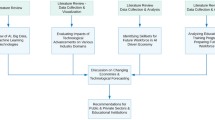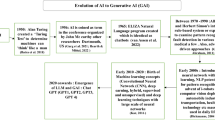Abstract
In order to gain competitive advantage, technology opportunity detection in the latest and fast-growing areas has been becoming an important research issue. However, current research on technology opportunity detection is often focus on verifying the technology opportunities that have occurred, using the accumulated data from a specific field. Because of the time needed for data accumulation, these methods often have a substantial time lag and hard to early detect technology opportunities. It also leads to challenges to explore technology opportunities which still have not been covered in the current dataset. Moreover, phrase has more semantics than words but still rarely used and semantic represented in the process of technology opportunity detection. Therefore, this paper proposes a method based on analogy design and phrase semantic representation for early detection of technology opportunity. Firstly, the source field corresponding to target field for analogy design is carefully selected, thus indirectly expanding the data coverage of the target field through the data from the source field. Secondly, effect phrases in both source field and target field are automatically extracted by BiLSTM-CRF and semantic represented by representation learning, then the analogy relationships are established through topic clustering on overall data. Finally, the scores of the topics are calculated based on ODI (outcome-driven innovation) and the topics with a high score are considered as early detected technology opportunities. The proposed method is validated using analogy between 3G and 4G. In this process, 3G is used as the source and 4G patents published in the early stage are used as the target for detecting technology opportunities in 4G, and the rest 4G patents published in the later stage are used for detecting the actual evolution results of technology opportunities. The comparison results prove that every detected technology opportunity in the early stage matches one or more topics of the actual evolution results in the later stage. In addition, this paper uses analogy between 4G (source field) and 5G (target field) for technology opportunities prediction, which may provide useful and helpful results for decision making in 5G and a good example for further application in other areas. These results have proved that the proposed method is effective and useful. Simultaneously, this method is a preliminary research and still need to be further studied on other datasets with different analogy types.





Similar content being viewed by others
References
Agyemang, M., Linsey, J., & Turner, C. (2017). Transforming functional models to critical chain models via expert knowledge and automatic parsing rules for design analogy identification. Artificial Intelligence for Engineering Design, Analysis and Manufacturing, 31, 501–511. https://doi.org/10.1017/S0890060417000488.
Arefyev, N., Ermolaev, P., & Panchenko, A. (2018). How much does a word weigh? Weighting word embeddings for word sense induction. In Paper presented at the proceedings of the 24th International Conference on Computational Linguistics and Intellectual Technologies, Moscow, Russia.
Catrambone, R. (2002). The effects of surface and structural feature matches on the access of story analogs. Journal of Experimental Psychology. Learning, Memory, and Cognition, 28, 318–334. https://doi.org/10.1037//0278-7393.28.2.318.
Chan, J., Fu, K., Schunn, C., Cagan, J., Wood, K., & Kotovsky, K. (2011). On the effective use of design-by-analogy: The influences of analogical distance and commonness of analogous designs on ideation performance. In ICED 11–18th international conference on engineering design—impacting society through engineering design (Vol. 7, pp. 85–96).
Chen, X., Xu, L., Liu, Z., Sun, M., & Luan, H. (2015). Joint learning of character and word embeddings. In Paper presented at the proceedings of the 24th international conference on artificial intelligence, Buenos Aires, Argentina.
Cho, C., Yoon, B., Coh, B.-Y., & Lee, S. (2016). An empirical analysis on purposes, drivers and activities of technology opportunity discovery: The case of Korean SMEs in the manufacturing sector. R&D Management, 46(1), 13–35. https://doi.org/10.1111/radm.12107.
Choe, H., Lee, D. H., Seo, I. W., & Kim, H. D. (2013). Patent citation network analysis for the domain of organic photovoltaic cells: Country, institution, and technology field. Renewable and Sustainable Energy Reviews, 26, 492–505. https://doi.org/10.1016/j.rser.2013.05.037.
Choi, J., Jeong, B., & Yoon, J. (2019). Technology opportunity discovery under the dynamic change of focus technology fields: Application of sequential pattern mining to patent classifications. Technological Forecasting and Social Change. https://doi.org/10.1016/j.techfore.2019.119737.
Christensen, B. T., & Schunn, C. D. (2007). The relationship of analogical distance to analogical function and preinventive structure: the case of engineering design. Memory Cognition, 35(1), 29–38. https://doi.org/10.3758/bf03195939.
De Boom, C., Van Canneyt, S., Demeester, T., & Dhoedt, B. (2016). Representation learning for very short texts using weighted word embedding aggregation. Pattern Recognition Letters, 80, 150–156. https://doi.org/10.1016/j.patrec.2016.06.012.
Fu, X., Ch’Ng, E., Aickelin, U., & See, S. (2017). CRNN: A joint neural network for redundancy detection. In 2017 IEEE international conference on smart computing (SMARTCOMP).
Fu, K., Murphy, J., Yang, M., Otto, K., Jensen, D., & Wood, K. (2015). Design-by-analogy: Experimental evaluation of a functional analogy search methodology for concept generation improvement. Research in Engineering Design, 26(1), 77–95.
Geroski, P. A. (1990). Innovation, technological opportunity, and market structure. Oxford Economic Papers, 42(3), 586–602.
Goel, A. K., & Bhatta, S. R. (2004). Use of design patterns in analogy-based design. Advanced Engineering Informatics, 18(2), 85–94.
Goldstone, R. L., Medin, D. L., & Gentner, D. (1991). Relational similarity and the nonindependence of features in similarity judgments. Cognitive Psychology, 23(2), 222–262. https://doi.org/10.1016/0010-0285(91)90010-L.
Hill, A., & Paris, J. (2013). The counterpart principle of analogical support by structural similarity. Erkenntnis, 79, 1169–1184. https://doi.org/10.1007/s10670-013-9546-0.
Hope, T., Chan, J., Kittur, A., & Shahaf, D. (2017). Accelerating innovation through analogy mining. In Paper presented at the Proceedings of the 23rd ACM SIGKDD international conference on knowledge discovery and data mining, Halifax, NS, Canada.
Huang, L., Wang, J., Xin, L., & Wang, L. (2016). Detecting technology opportunities based on papers and patents for perovskite solar cells. Journal of the China Society for Scientific and Technical Information, 35(7), 686–695.
Jayabharathy, J., Kanmani, S., & Parveen, A. (2011). Document clustering and topic discovery based on semantic similarity in scientific literature. In Paper presented at the proceedings of the 3rd International Conference on Communication Software and Networks, Xi'an, China. https://doi.org/10.1109/ICCSN.2011.6014600.
Jeong, C., & Kim, K. (2014). Creating patents on the new technology using analogy-based patent mining. Expert Systems with Applications, 41(8), 3605–3614.
Jia, L. Z., Wu, C. L., Zhu, X. H., & Tan, R. H. (2018). Design by analogy: Achieving more patentable ideas from one creative design. Chinese Journal of Mechanical Engineering, 31(02), 25–34.
Kim, B., Gazzola, G., Yang, J., Lee, J.-M., Coh, B.-Y., Jeong, M. K., et al. (2017). Two-phase edge outlier detection method for technology opportunity discovery. Scientometrics, 113(1), 1–16. https://doi.org/10.1007/s11192-017-2472-1.
Kingma, D., & Ba, J. (2014). Adam: A method for stochastic optimization. In Paper presented at the proceedings of the 3rd International Conference for Learning Representations, San Diego, USA.
Le, Q., & Mikolov, T. (2014). Distributed representations of sentences and documents. In 31st International conference on machine learning, ICML 2014, (Vol. 4).
Lee, C., Kang, B., & Shin, J. (2015). Novelty-focused patent mapping for technology opportunity analysis. Technological Forecasting and Social Change, 90, 355–365.
Lee, J., Kim, C., & Shin, J. (2017). Technology opportunity discovery to R&D planning: Key technological performance analysis. Technological Forecasting and Social Change, 119, 53–63. https://doi.org/10.1016/j.techfore.2017.03.011.
Lee, S., Yoon, B., & Park, Y. (2009). An approach to discovering new technology opportunities: Keyword-based patent map approach. Technovation, 29(6–7), 481–497.
Lei, Z., Wang, G., & Zou, X. A study of Chinese document representation and classification with Word2vec. In 2016 9th International symposium on computational intelligence and design (ISCID), 2016.
Linsey, J. (2007). Design-by-analogy and representation in innovative engineering concept generation. Dissertation Abstracts International, 69(01), 1–410.
Ma, X., & Hovy, E. (2016). End-to-end sequence labeling via bi-directional LSTM-CNNs-CRF. arXiv e-prints.
Mikolov, T., Sutskever, I., Chen, K., Corrado, G., & Dean, J. (2013). Distributed representations of words and phrases and their compositionality. In Proceedings of the 26th international conference on neural information processing systems (Vol. 2). Lake Tahoe, Nevada: Curran Associates Inc.
Nieto, M., & Quevedo, P. (2005). Absorptive capacity, technological opportunity, knowledge spillovers, and innovative effort. Technovation, 25(10), 1141–1157. https://doi.org/10.1016/j.technovation.2004.05.001.
Olsson, O. (2005). Technological opportunity and growth. Journal of Economic Growth, 10(1), 31–53.
Orloff, M. (2003). Inventive Thinking through TRIZ. Berlin, Heidelberg: Springer. https://doi.org/10.1007/978-3-540-33223-7.
Peter, S., & James, O. (1979). The emergent paradigm: Changing patterns of thought and belief. Menlo Park: SRI International.
Pinegar, J. S. (2006). What customers want: Using outcome-driven innovation to create breakthrough products and services by Anthony W. Ulwick. Journal of Product Innovation Management, 23(5), 464–466.
Porter, A. L., & Detampel, M. J. (1995). Technology opportunities analysis. Technological Forecasting and Social Change, 49(3), 237–255. https://doi.org/10.1016/0040-1625(95)00022-3.
Qin, P., Xu, W., & Guo, J. (2016). A novel negative sampling based on TFIDF for learning word representation. Neurocomputing, 177, 257–265. https://doi.org/10.1016/j.neucom.2015.11.028.
Schnotz, W., & Baadte, C. (2015). Surface and deep structures in graphics comprehension. Memory & Cognition, 43, 605–618. https://doi.org/10.3758/s13421-014-0490-2.
Seo, W., Yoon, J., Park, H., Coh, B.-Y., Lee, J.-M., & Kwon, O.-J. (2016). Product opportunity identification based on internal capabilities using text mining and association rule mining. Technological Forecasting and Social Change, 105, 94–104.
Shaobo, L. I., Zheng, W. U., Yang, G., Jie, H. U., & Liya, Y. U. (2017). Patent mining algorithm based on analogy design. Computer Integrated Manufacturing Systems, 23(11), 2344–2352.
Song, K., Kim, K. S., & Lee, S. (2017). Discovering new technology opportunities based on patents: Text-mining and F-term analysis. Technovation, 60–61, 1–14. https://doi.org/10.1016/j.technovation.2017.03.001.
Tihanyi, L., Johnson, R. A., Hoskisson, R. E., & Hitt, M. A. (2003). Institutional ownership differences and international diversification: The effects of boards of directors and technological opportunity. The Academy of Management Journal, 46(2), 195–211. https://doi.org/10.2307/30040614.
Tomko, M., Lucero, B., Turner, C., & Linsey, J. (2015). Establishing functional concepts vital for design by analogy. In 2015 IEEE Frontiers in education conference (FIE), 21–24 Oct. 2015 (pp. 1–8). https://doi.org/10.1109/fie.2015.7344193.
Turney, P. D., Littman, M. L., Bigham, J., & Shnayder, V. (2003). Combining independent modules to solve multiple-choice synonym and analogy problems. In Paper presented at the International Conference on Recent Advances in Natural Language Processing, Borovets, Bulgaria.
Wang, M.-Y., Fang, S.-C., & Chang, Y.-H. (2015). Exploring technological opportunities by mining the gaps between science and technology: Microalgal biofuels. Technological Forecasting and Social Change, 92, 182–195. https://doi.org/10.1016/j.techfore.2014.07.008.
Wang, X., & Gu, Y. (2017). Cross-label suppression: A discriminative and fast dictionary learning with group regularization. IEEE Transactions on Image Processing, 26(8), 3859–3873. https://doi.org/10.1109/TIP.2017.2703101.
Xin, L., Wang, J., Huang, L., Jiang, L., & Jian, L. (2010). Empirical research on the technology opportunities analysis based on morphology analysis and conjoint analysis. Foresight, 12(2), 66–76.
Yoon, J., & Kim, K. (2012). Detecting signals of new technological opportunities using semantic patent analysis and outlier detection. Scientometrics, 90(2), 445–461.
Yoon, B., & Magee, C. L. (2018). Exploring technology opportunities by visualizing patent information based on generative topographic mapping and link prediction. Technological Forecasting and Social Change, 132, 105–117. https://doi.org/10.1016/j.techfore.2018.01.019.
Yoon, B., & Park, Y. (2005). A systematic approach for identifying technology opportunities: Keyword-based morphology analysis. Technological Forecasting and Social Change, 72(2), 145–160. https://doi.org/10.1016/j.techfore.2004.08.011.
Yoon, J., Park, H., Seo, W., Lee, J.-M., Coh, B.-Y., & Kim, J. (2015). Technology opportunity discovery (TOD) from existing technologies and products: A function-based TOD framework. Technological Forecasting and Social Change, 100, 153–167. https://doi.org/10.1016/j.techfore.2015.04.012.
Zhu, L., Wang, G., & Zou, X. (2016). A study of Chinese document representation and classification with Word2vec. In 2016 9th International symposium on computational intelligence and design (ISCID), 10–11 December. 2016 (Vol. 1, pp. 298–302). https://doi.org/10.1109/iscid.2016.1075.
Funding
This work is supported by the National Natural Science Foundation of China (Grant No. 71974095), the Social Science Foundation of Jiangsu Province of China (Grant No. 17TQC003) and the National Natural Science Foundation of China (Grant No. 71503125).
Author information
Authors and Affiliations
Corresponding author
Rights and permissions
About this article
Cite this article
Zhang, J., Yu, W. Early detection of technology opportunity based on analogy design and phrase semantic representation. Scientometrics 125, 551–576 (2020). https://doi.org/10.1007/s11192-020-03641-z
Received:
Published:
Issue Date:
DOI: https://doi.org/10.1007/s11192-020-03641-z




